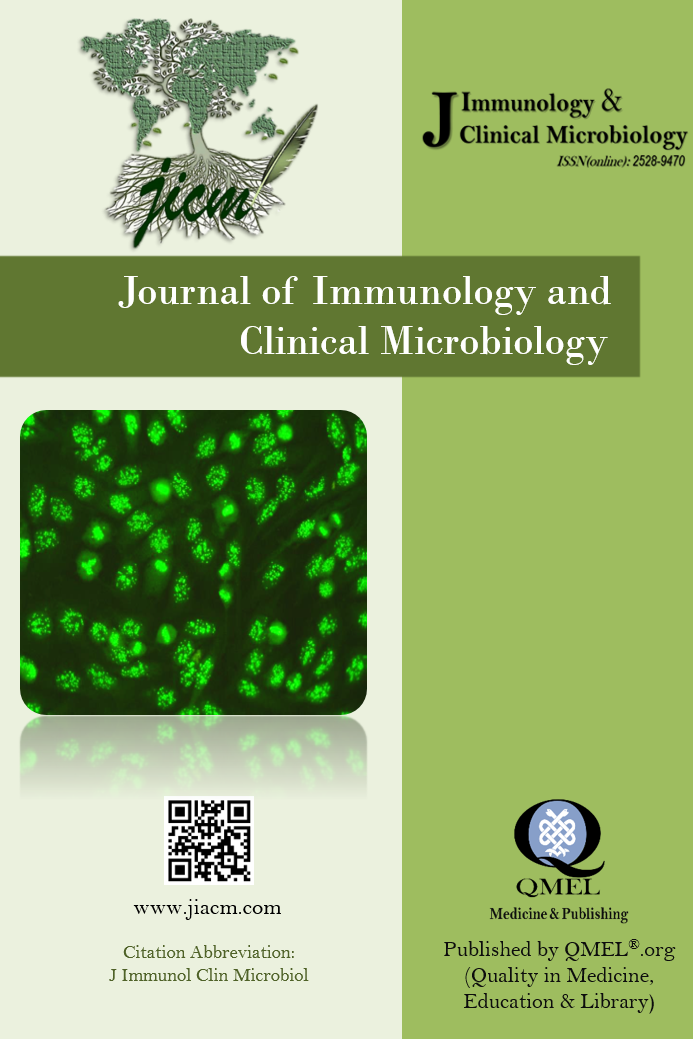Microbiological Evaluation of the Clinical Isolated Patients in the General Adult Intensive Care Unit
Microbiological Evaluation of the Clinical Isolated Patients in the General Adult Intensive Care Unit
Objective: In this study; microbiological evaluation of clinical isolates of 490 patients treated in general adult intensive care unit between 2016-2018 was aimed.
Methods: Blood culture samples were evaluated in an automated blood culture system BacT / Alert 3D (bioMerieux, France). Vitek 2 Compact (BioMe´rieux, Marcyl’Etoile, France) automated bacterial identification system was used for determination of biochemical parameters and antibiograms. Statistical Package for the Social Sciences (SPSS) Version 23.0 (SPSS Inc., Chicago, IL, USA) was used to analyze the data.
Result: In this study; non-fermentative gram negative microorganisms were found to be 10.816% (n = 53). Pseudomonas aeroginosa were detected in 49 patients (10%). Especially in 2018, the total number of microorganisms was found to be higher than the other years, while P. aeroginosa strain (n = 41) increased significantly. The major pathogens were P. aeroginosa, Non-Fermentative Gr (-) bacteria, Klepsiella spp., Escherichia coli, Candida spp., Proteus spp., Pseudomonas spp. was determined.
Conclusion: In this study; microorganism distribution of patients hospitalized in intensive care unit was determined. Investigating the resistance status of microorganisms will be useful in regulating treatment protocols and preventing resistant pathogenic microorganisms.
Keywords:
Pathogen, Culture, Adult İntensive Care, Turkey,
___
- 1. Anderson DJ, Podgorny K, Berríos-Torres SI, Bratzler DW, Dellinger EP, Greene L. Strategies to Prevent Surgical Site Infections in Acute Care Hospitals: 2014 Update. Infection Control and Hospital Epidemiology 2014; 35(6):305-37.
- 2. D’Agata EM, Thayer V, Schaffner W. An outbreak of Acinetobacter baumannii: the importance of cross-transmission. Infect Control Hosp Epidemiol 2000; 21(9): 588-91.
- 3. Barış A, Bulut ME, Öncül A, Bayraktar B. Yoğun Bakım Ünitelerinde Yatan Hastalara Ait Klinik İzolatların Tür Dağılımı ve Antibiyotik Duyarlılıkları. Journal of the Turkish Society of Intensive Care 2017;15(1):21-27.
- 4. Sugeçti S, Koçer F. Antimicrobial Activity Against Clinical Pathogenic Microorganisms of Commercially Important Natural Extract, Anadolu Doğa Bilimleri Dergisi 2015;6 (2): 28-34.
- 5. Uslu S, Bolat F, Can E, Comert S, Nuhoğlu A. Yenidoğan yoğun bakım ünitelerinde hastane enfeksiyonlarını önleme çalışmaları. Bakırköy Tıp Dergisi 2010; 6(1):1-7.
- 6. Estripeaut D, Sáez-Llorens X. Perinatal Bacterial Diseases, In: Feigin RD, Cherry JD, Demmler-Harrison GJ, Kaplan SL (Eds): Feigin & Cherry’s Textbook of Pediatric Infectious Diseases. 6th edition, Saunders-Elsevier, Philadelphia, USA 2009:979-1020.
- 7. Edwards MS, Baker CJ. Bacterial Infections in the Neonate, In: Long SS, Pickering LK, Prober CG (Eds): Principles and Practice of Pediatric Infectious Diseases. 3th ed, Elsevier, China 2008:532-9.
- 8. Clinical and Laboratory Standards Institute. Performance Standards for Antimicrobial Testing. Seventeenth Informational Supplement (M100-S16). Wayne, PA: CLSI, 2007.
- 9. Banerjee SN, Grohskopf LA, Sinkowitz‐Cochran RL, Jarvis WR, Network PP, System NNIS. Incidence of pediatric and neonatal intensive care unit–acquired infections. Infect Control Hosp Epidemiol. 2006;27(6):561-70.
- 10. Sağlam D, Erçal B. D, Yağmur G, Öz HTH, Akın MA, Berk E. Kayseri Eğitim Araştırma Hastanesi yenidoğan yoğun bakım ünitelerinde kan kültürlerinden izole edilen mikroorganizmaların dağılımı. Abant Tıp Dergisi, 2015;4(3):255-260.
- 11. İnan D, Saba R, Keskin S, et al. Akdeniz Üniversitesi Hastanesi yoğun bakım ünitelerinde hastane infeksiyonları. Yoğun Bakım Dergisi, 2002;2(2): 129-135.
- 12. Çetin ES, Kaya S, Pakbaş İ, Demirci M. Yoğun bakım ünitelerinde yatan hastalardan izole edilen mikroorganizmalar ve antibiyotik duyarlılıkları. İnönü Üniversitesi Tıp Fakültesi Dergisi 2007;14(2):69-73.
- 13. Şahin AR, Yıldız BT, Aktemur A, Topal B, Nazik S, Ateş S. Bir Üniversite Hastanesi Noroloji Yoğun Bakım Ünitesinde Gelişen Enfeksiyonların Değerlendirilmesi. Çağdaş Tıp Dergisi, 2019; 9(1), 43-47.
- 14. Taş SŞ, Kahveci K. Uzun Süreli Yoğun Bakım Ünitesi ve Palyatif Bakım Merkezinde Hastane Enfeksiyonlarının Sürveyansı; 3 Yıllık Analiz. Çağdaş Tıp Dergisi, 2018; 8(1), 55-59.
- 15. Taşbent FE, Doğan M. Yoğun Bakım Hastalarında Kan Kültürlerinde Üreyen Mikroorganizmaların Değerlendirilmesi. Journal of Molecular Biology and Biotechnology (MOLBİOTECH) 2018; 2(2), 05-08.
- 16. Ertürk A, Çopur ÇA, Köksal E, Şentürk KZ, Özyurt S. Yoğun bakım ünitesinde yatan hastaların çeşitli klinik örneklerinden izole edilen mikroorganizmalar ve antibiyotik duyarlılıkları. Ankem Derg, 2012;26(1):1-9.
- Yayın Aralığı: Yılda 4 Sayı
- Başlangıç: 2016
- Yayıncı: Erkan YULA
Sayıdaki Diğer Makaleler
ÇOCUKLUK YAŞ GRUBUNDA NADİR GÖRÜNEN BİR OLGU SUNUMU: RADIUS'TA SALMONELLA OSTEOMYELİTİ
Yaşar DİNÇEL, Abdülkadir SARI, Mehmet Ümit ÇETİN, Melih GÜNEY, Burak GÜNAYDIN, Erdem CAN
Gülay BÖREKÇİ, İrem BEKALP, Özlem KANDEMİR, Ayşegül ÇETİNKAYA, Gülhan OREKİCİ TEMEL, Nurcan ARAS
Gülşah YAŞA ÖZTÜRK, Ferda ÖZDEMİR, Selçuk ÖZTÜRK, Cem COPUROGLU, Gülay ALTUN, Mehmet KÜRKCÜ_ÇENE CERRAHİSİ, Nermin TUNÇBİLEK, Necdet SÜT
Serkan SUGEÇTİ, Ali Bestami KEPEKÇİ, Merve ZIVALI, Ferudun KOÇER
